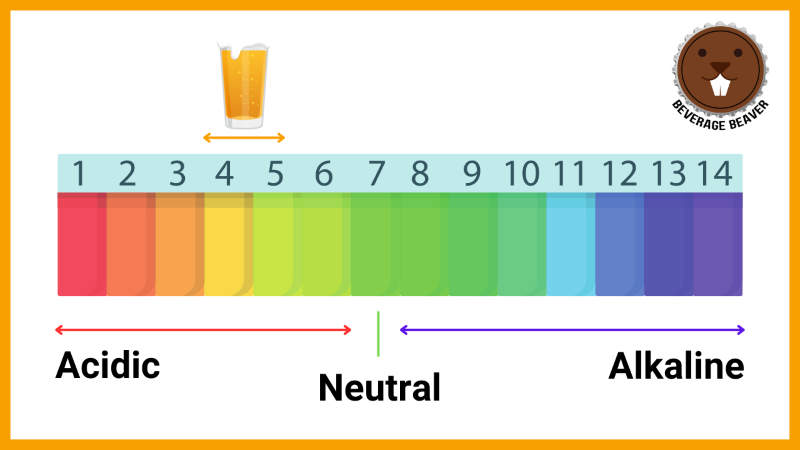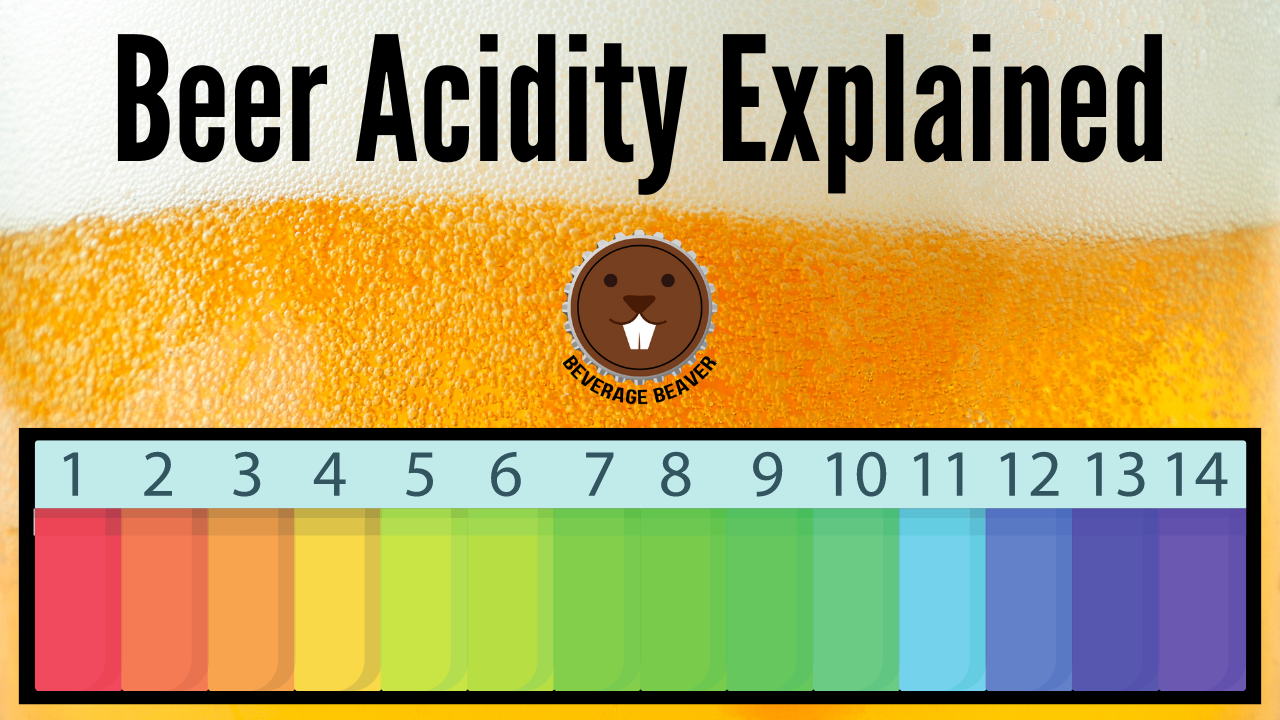Beer Acidity Explained | A Useful Guide For Beer Drinkers And Brewers
Acidity, measured on the pH scale, can affect a beer’s taste, stability, and ability to pair with certain foods. If you’re an aspiring beer brewer, understanding the nuances of beer acidity will help you to fine-tune your recipes, ensuring that each batch achieves its desired flavor profile.
On the other hand, if you’re a beer consumer and want to understand the subtle tastes in your beer, or want to know which beers are more acidic than others for the perfect food pairing, then grasping the concept of beer acidity is incredibly useful. In this guide, we will explain in detail the acidity of beer, the differences in acidity between various beer styles, and the broader implications for both brewers and consumers.
The pH Scale: A Quick Primer
In order to understand beer acidity, we must first know the basics of the pH scale – the foundation upon which our understanding of acidity stands. The pH scale is a logarithmic scale ranging from 0 to 14 that indicates how acidic or alkaline a solution is. A value of 7 on the pH scale is neutral, like distilled water. Values less than 7 suggest an acidic nature and above 7 are alkaline.
Most beers generally fall in the range of 4 to 5.5 on the pH scale. This mild acidity contributes to the refreshing character of beer. However, as we’ll explore further, various factors, from the ingredients chosen to the brewing techniques employed, can shift this pH, crafting beers that span a spectrum from the crisply acidic to the subtly mellow.
If you’re an aspiring beer brewer, it is vital that you understand that the pH scale is not linear, and a lower pH number is actually more acidic. For example, a beer with a pH of 4 is ten times more acidic than one with a pH of 5. Knowing this key information can make all the difference when aiming for precision in brewing.
Is Beer Acidic?
Beer does lean towards the acidic side of the pH scale. Most commercial beers typically fall within the pH range of 4 to 5.5. To put this into perspective, beer’s acidity is milder than common beverages like coffee or orange juice but is generally more acidic than plain water. The natural acidity in beer is pivotal in enhancing its flavor profile, providing the crisp and refreshing mouthfeel that many beer enthusiasts cherish.

Factors That Influence the Acidity of Beer
Ingredients:
The basic components of beer – water, malt, hops, and yeast – all play a role in determining its final pH.
- Malt: Different malts can introduce varying levels of acidity. Darker malts, for instance, tend to impart a slightly lower pH (more acidic) than lighter ones.
- Hops: While hops are more commonly associated with bitterness, they can also affect a beer’s acidity, especially when used in large quantities.
- Yeast: The fermentation process, driven by yeast, is inherently acidic. Certain yeast strains and fermentation methods can produce more acidic compounds than others.
Brewing Process:
The stages of brewing, from mashing to boiling to fermentation, all influence the beer’s final acidity. For instance, the temperature and duration of the mash can affect the pH, with a longer mash at a specific temperature range extracting more acidic compounds from the grains.
Aging:
Aging beer, especially in wood barrels, can introduce additional acidic compounds. Sour beers, which are intentionally aged to develop tart or sour flavors, can see a drop in pH as a result of the microbes introduced and the interaction with the wood.
The Acidity Of Difference Beer Styles
While all beer is inherently acidic, not all beers have the same acidity. Each beer style uses unique ingredients and brewing techniques, resulting in a diverse spectrum of acidity levels. Here is a list of common beer styles together with their typical acidity.
Ales
- Typical pH: Ales generally fall within the pH range of 4 to 5.5, similar to most beers.
- Acidity Factors: Ales encompass many subtypes, from pale ales to stouts. Darker ales, with their roasted malts, can lean towards the more acidic side of this range. The yeast strains used for fermenting ales also often produce fruity esters, which, while not acidic themselves, can accentuate the perception of acidity.
Lagers
- Typical pH: Lagers typically range between 4.4 to 5.2.
- Acidity Factors: Lagers are brewed with bottom-fermenting yeast strains at colder temperatures, generally resulting in a crisper and often slightly less acidic profile than ales. The malt bills for lagers, especially lighter ones like pilsners, may also lead to a somewhat milder acidity.
Specialty and Sour Beers
- Typical pH: These can vary widely but often reside in the 3 to 4.5 range, making them noticeably more acidic than standard ales and lagers.
- Acidity Factors: Beers like Berliner Weisse, Lambics, and Gose are intentionally brewed to accentuate sourness. This is achieved through specific fermentation techniques, using wild yeasts and bacteria, and often extended aging, all of which contribute to a pronounced acidic character.
Non-alcoholic Beers
- Typical pH: Generally, non-alcoholic beers have a pH range similar to their alcoholic counterparts, around 4 to 5.5.
- Acidity Factors: While the removal of alcohol doesn’t inherently alter the pH, the methods used for de-alcoholization and potential recipe adjustments might cause slight variations in the beer’s acidity.
Which Beers Are Least Acidic?
Acidity is inherent in beer, but some are less acidic than others. Generally speaking, most commercial lagers (such as Stella Artois, Heineken, Budweiser, etc.) are slightly acidic, with a range of 4-5.5 on the pH scale. Ales, on the other hand, can have a wide range of acidity levels, ranging from 3 (quite acidic) to 6 (a little acidic) on the pH scale.
If you’re wondering which beers are least acidic because you’re worried about acid reflux, then there’s much more to consider than the pH level of beer. See this helpful article on beer and acid reflux for more information.
Beer Acidity And Food Pairing
Acidity in beer serves several roles in food pairings. It acts as a palate cleanser, similar to how a dash of lemon elevates and balances a fatty fish, making acidic beers a refreshing complement to richer dishes. This acidity also heightens certain food flavors, especially in tangy dishes, leading to more pronounced and vibrant taste experiences.
The art of beer-food pairing also thrives on contrasts; a sour ale might beautifully counterbalance the sweetness of a dessert. Moreover, the intensity of a highly acidic beer demands a dish with equal gusto, ensuring a harmonious balance where neither the drink nor the meal overshadows the other.
Here are some examples of beer-food pairings based on beer acidity:
- Sour Ales: With their pronounced acidity, sour ales, like Berliner Weisse or Gose, pair beautifully with fresh salads featuring vinaigrettes, ceviche, or even a goat cheese tart. Their sharpness complements the tang in such dishes.
- Belgian Tripels: These ales often have a gentle acidity coupled with some sweetness. They pair well with spicy dishes, like Thai or Indian cuisine, as the acidity can cut through the spice, and the malt sweetness can provide a balancing effect.
- IPA (India Pale Ale): While primarily known for their hop bitterness, many IPAs also have a mild to moderate acidity that complements grilled meats, particularly those with a charred or caramelized exterior.
- Wheat Beers: With their light and often citrusy acidity, wheat beers like Hefeweizens are a perfect match for light seafood dishes, lemon chicken, or even sushi.
- Stouts: While not typically very acidic, the roasted malts in stouts can play well with the natural acidity in dishes like BBQ meats, enhancing the smoky and tangy elements of the sauce.
Controlling Acidity in Beer: Tips for Homebrewers
While acidity plays a crucial role in flavor and mouthfeel, there may be times when a homebrewer wishes to tone down the tartness of their beer. Whether you’re aiming for a smoother profile or adjusting to personal taste, here are some pointers to help control and reduce the acidity in your homebrew:
- Water Profile: Begin with your water chemistry. Adjusting the water profile can significantly impact the beer’s pH. Use bicarbonates or calcium carbonate (chalk) to raise the pH of the water, making it more alkaline and thereby reducing perceived acidity.
- Malt Choice: Opt for base malts with a higher buffering capacity, like pale malts, which can help neutralize some of the acids during the mash process.
- Limit Acidulated Malts: Acidulated malt is often used to adjust the pH of the mash, but if you’re looking to reduce acidity, use it sparingly or not at all.
- Mash pH Monitoring: Monitoring and controlling your mash pH is crucial. Aim for a pH range of 5.2 to 5.6. Using pH stabilizers or pH meters can help you stay within this range.
- Boil Additions: Limit the use of ingredients that can increase acidity, like certain fruits or spices, during the boiling phase.
- Fermentation Control: Some yeast strains produce more acidic by-products than others. Opt for yeast strains known for producing milder acidity. Also, consider controlling fermentation temperatures, as higher temperatures can sometimes lead to increased acid production.
- Post-Fermentation Adjustments: If the beer is still more acidic than desired, you can use additives like potassium bicarbonate to adjust the pH post-fermentation.
- Limit Oxygen Exposure: Oxygen can lead to the production of acetic acid in beer. To prevent this, ensure a proper seal during fermentation and be mindful during transfers.
Wrapping Up
While beer inherently possesses a degree of acidity, it is notably less acidic than beverages like juice or coffee. The complexity of beer’s acidity stems from various factors, ranging from the ingredients and brewing process to the type of beer itself. As we’ve explored, understanding this acidity is invaluable for homebrewers aiming for precise flavor profiles and consumers seeking the perfect food pairing.


